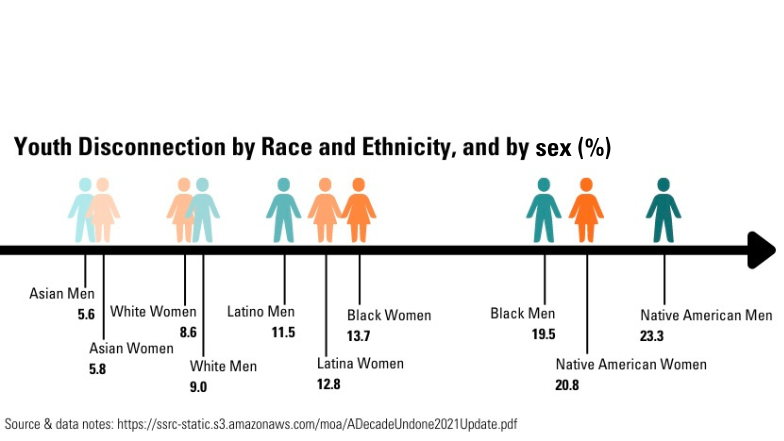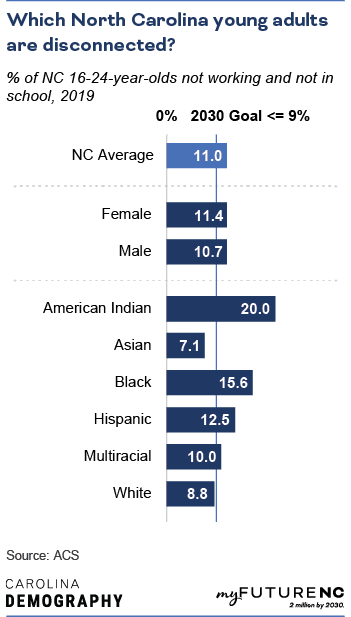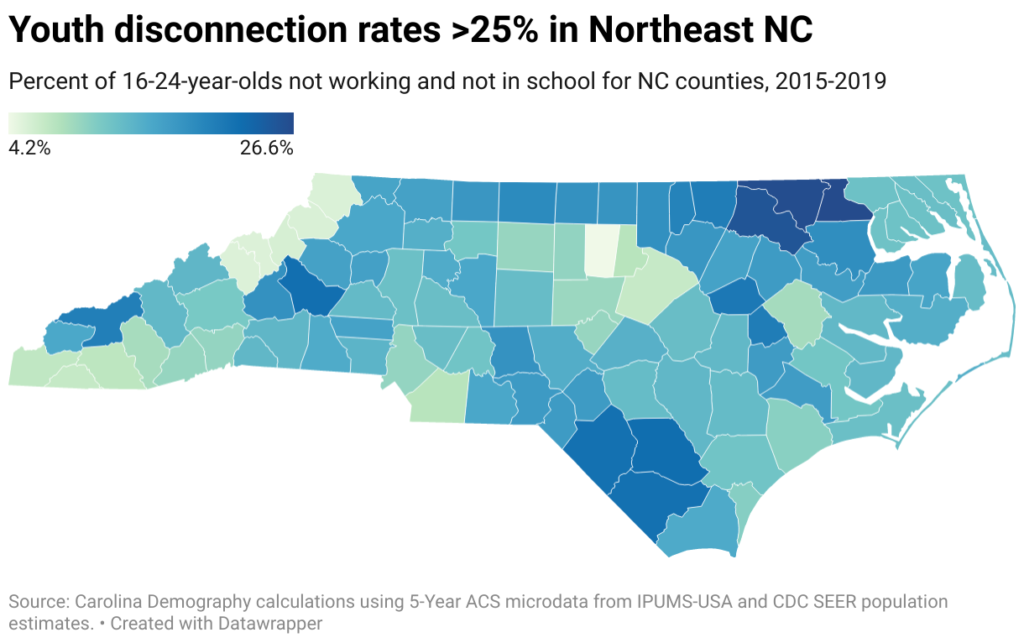The Employment of Opportunity Youth
Data Brief by Brodie Smith, IEI Policy Intern
Completed 9/21/2022
Who are Opportunity Youth?
Opportunity Youth, commonly referred to as “disconnected youth,” are defined as teens and young adults between the ages of 16 and 24 who are neither in school nor working. The term “disconnected youth” is not entirely accurate, however, as these youth most often have friends, family, neighborhoods and other communities of support—so the term “opportunity youth,” more accurately highlights the opportunities that could be sought out and that should be provided for them.
Highlights
- Opportunity youth are almost twice as likely to live in poverty, three times more likely to have one or more disabilities and eight times less likely to have finished high school. Female opportunity youth are more than four times as likely to be mothers.
- In 2019, about 10.7% of all youths, approximately 4,114,500 individuals, fell into the category of opportunity youth nationally.
- In North Carolina, the rate of opportunity youth in 2019 was 11%, which is approximately 141,000 individuals.
- Three North Carolina counties (Hertford, Northampton and Halifax) have opportunity youth rates over 25%, meaning about 1 in 4 youth in those counties fall into the opportunity youth category.
- In October 2021, the unemployment rate for opportunity youth was nearly double that of the general civilian labor force at 9%.
Characteristics of Opportunity Youth
Opportunity youth are a vastly diverse group of individuals, and they differ greatly from their “connected” counterparts. These differences go beyond current employment and educational status and have remained roughly stable over the course of the last decade. According to the 2021 Measure of America report on youth disconnection nationally:
- 30.9% of opportunity youth live in poverty. Those numbers grow for the opportunity youth who identify as Black and Native American women (42.7% and 41.6%, respectively).
- Opportunity youth are also three times more likely to have one or more disabilities than connected youth (17.4% vs. 5.4%). The groups with the highest rates of disability were White opportunity youth at 21.6%, followed by Black opportunity youth at 15%.
- Female opportunity youth are four times more likely to be mothers with a rate of 24%.
- Opportunity youth ages 16 and 17 are more likely to be living apart from both of their parents, with a rate of 21.7%.
- Opportunity youth are eight times more likely to have not finished high school, with a rate of 23.8% not receiving a high school diploma or GED.
- 52.3% of opportunity youth have received a high school diploma but have no further education.
On top of all this, opportunity youth are also much more likely to experience homelessness, to be uninsured, become incarcerated and experience physical, sexual or mental abuse.
National Data on Opportunity Youth
By 2019, the United States youth population (individuals ages 16-24) was approximately 38,583,300. That same year, the percentage of that population that fell into the category of opportunity youth was 10.7% (about 4,114,500 opportunity youth in the United States). To put that number into perspective, that is about the size of Oklahoma’s population and about twice that of New Mexico. This rate of opportunity youth varies across sex, race and ethnicity. The group with the highest rates of opportunity youth at 23.3% are Native American Men; meanwhile Asian Men have the lowest rates of opportunity youth at 5.6%. The graph below displays the breakdown of each race/ethnicity group separated by sex.

To read more about national trends with opportunity youth, check out Measure of America’s interactive tool.
North Carolina Data on Opportunity Youth
As of 2019, 11%, approximately 141,000 people, of North Carolina youths (individuals ages 16-24) identified as opportunity youth. This means that about 1 in every 9 youths in North Carolina were neither employed nor in school. Leading up to the COVID-19 pandemic, the rate of opportunity youth has been at a steady decline since the peak in 2011 with a rate of 16.2%.
Similarly to national data, North Carolina has higher rates of opportunity youth amongst people of color, especially for Native American and Black youth. Native Americans in North Carolina have the highest rate of opportunity youth at 20%, followed by Black youth at 15.6% and Hispanic youth at 12.5%. Meanwhile, Asian youth in North Carolina have the lowest rate of opportunity youth at 7.1%, with White youth coming in second with 8.8%.
To look at North Carolina youth separated by sex, we can see that females have a higher rate of opportunity youth at 11.4% with their male counterparts at 10.7%. If we break up the age range of opportunity youth, the rate of opportunity youth for women ages 16-19 in North Carolina is 5.9%, meanwhile men in the same age group have a higher rate at 7.8%. However, the rate of opportunity youth for women ages 20-24 is almost two times more than that of women 16-19 (16.3% vs. 5.9%).

County Data on Opportunity Youth
Across North Carolina’s 100 counties, the rate of opportunity youth varies greatly. The counties with the lowest opportunity youth rates are Orange (4.2%), Yancey (5.5%) and Mitchell (5.5%). Meanwhile, three northeastern counties in North Carolina come in as the counties with the highest opportunity youth rates, all over 25%. These counties are Hertford (26.6%), Northampton (26.4%) and Halifax (25.4%). The map below shows the rate of opportunity youth in all 100 North Carolina counties.

If we look at the counties by the population of opportunity youth rather than the rate, then you see that the county with the largest opportunity youth population is Mecklenburg at about 12,500 individuals. Mecklenburg is followed by Wake with roughly 8,800 and Guilford with roughly 7,000. Five counties—Clay, Hyde, Mitchell, Tyrrell and Yancey—are estimated to have an opportunity youth population smaller than 100, primarily due to the small general population in the counties.
Employment Data
Now that we see how many of our youth in North Carolina, as well as the entire United States, become “disconnected” from educational opportunities and active employment, how do they perform when seeking employment in the labor market? According to the Bureau of Labor Statistics (BLS), the unemployment rate for all individuals ages 16 to 24 years, regardless of educational status, was 8% by October 2021. This same data set shows that there were about 20.8 million people ages 16 to 24 in the civilian labor force, those who are employed or are actively seeking employment, across the United States. Among those youth who were not enrolled in school, about 1.2 million were unemployed—a rate of 9%, which is almost twice that of the national unemployment rate at the time (4.6%).
This report from the BLS also breaks down unemployment data for opportunity youth by sex, race and ethnicity. For the opportunity youth that are a part of the civilian labor force, 55.7% identified as male, and 44.3% identified as female. The unemployment rate differed between males and females, with males in this population having an unemployment rate of 9.4% and females at 8.6%. To look at this same data by race and ethnicity, the group with the highest unemployment rate was Black individuals (13.7%), followed by Asian individuals (11.8%), Hispanic or Latino people (9.8%) and lastly White people (7.9%). (The BLS report did not include any data on Native American peoples due to the small sample sizes for their population.)
Barriers to Re-Engagement
As seen earlier, opportunity youth have higher rates of living in poverty, having a disability, receiving a limited education and several other obstacles that they will have to face in their lifetime. In addition to these factors, there are barriers that can make re-engagement more difficult once one is disconnected from school or work. These barriers include insecurities of some of the most basic needs, such as food, housing and access to healthcare. Many opportunity youth also face barriers surrounding the lack of access to reliable internet services, safe and affordable transportation and quality, affordable childcare.
Policies and Programs Surrounding Opportunity Youth
There are several congressional representatives in both chambers who have introduced federal legislation that would ultimately provide aid towards individuals who fall into the opportunity youth category. These pieces of legislation include but are not limited to:
H.R.4403 – Opening Doors for Youth Act of 2021
This bill would require the Department of Labor to provide funding for states for the development of youth employment programs that would (1) match youth participants with appropriate employers for high-quality employment opportunities; and (2) provide work-readiness training and educational programs, coaching and mentoring, career and postsecondary education planning services, financial literacy education, and supportive services.
H.R.6723/S.52 – Gateway to Careers Act of 2021
This bill establishes a career pathway grant program through which the Department of Education must award competitive grants to certain public institutions of higher education and postsecondary technical education schools. These grants must be used to (1) carry out activities that support the development and implementation of career pathway programs, and (2) provide support services to the students engaged in these programs.
H.R.854 – Youth Corps Act of 2021
This bill authorizes the Department of Labor to make grants to public or private nonprofit organizations to carry out Youth Corps programs that utilize the Youth Corps model to provide low-income youth (age 16 and not more than age 24) with education and work readiness training.
H.R.3107/S.1560 – Helping to Encourage Real Opportunities (HERO) for Youth Act of 2021
This bill modifies the work opportunity tax credit to (1) change the credit for summer youth employees to a credit for youth employees who will be employed for not more than 20 hours per week during any period between September 16 and April 30 in which the youth employee is attending any secondary school, (2) increase the amount of the credit for youth employees, and (3) expand the credit to include disconnected youth.
There are also various other programs and resources available in North Carolina, as well as the entire United States, that are meant to help provide support to youth, which can ultimately prevent youth from falling into the category of opportunity youth. A few of these programs and resources are:
NC’s Foster Care 18-21 Program
North Carolina launched Foster Care 18-21 in 2017, with the intention to assist young adults with their transition into adulthood while moving towards greater independence. This program allows youth who were placed in foster care to receive continued support from the age of 18 to when they are 21, this continued support includes: ongoing case work, placement in housing and foster care payments. This program helps prevent foster care youth from becoming opportunity youth by providing additional support into adulthood. North Carolina is one of multiple states with this program, which is a federally funded program beginning in 2008.
College Advising Corps
The College Advising Corps (CAC) is a national program with a mission to increase the number of low-income, first-generation college and underrepresented high school students who enter and complete higher education. CAC operates through their partner programs, run through postsecondary institutions, and works to support students by providing personalized guidance on the college admissions process, searching for financial aid/scholarships (including completing the FAFSA), and enrolling into higher education institutions. CAC has five partner programs in North Carolina: Appalachian State University, North Carolina State University, University of North Carolina at Chapel Hill, Duke University and University of North Carolina at Wilmington. CAC is funded by federal and state funding, with the North Carolina General Assembly voting to increase funding in the 2022 Appropriations Act, with the goal to have at least one College Adviser in every county in North Carolina.
NCWorks NextGen Program
The NCWorks NextGen Program provides opportunities for eligible youth between the ages of 16 and 24 to find a job and keep it. Staff members help qualifying youth learn how to set and accomplish goals, understand how to be a responsible employee, and start down a solid career path. Eligibility for services is determined by your local workforce development boards (WDB), but requirements include being between the ages 16-24, needing assistance with finding a career path and having at least one barrier to employment (i.e. dropped out of high school, low income, having a criminal background, pregnant or parenting, deficient in basic skills, experiencing homelessness, having a disability, being in the foster care system or being an English language learner).
Success in Action
GrowingChange, founded by Noran Sanford, is an organization that works to convert decommissioned rural prisons into sustainable farms and education centers. GrowingChange uses these renovated prisons to empower youth by challenging them to “rewrite their narrative.” This organization acknowledges the alarming rates of youth disconnection in North Carolina, and they strive to re-engage youth by providing sustainable agriculture skills while simultaneously receiving work experience. GrowingChange also partners with Scotland County Schools, Richmond Community College, UNC-Pembroke and NC A&T University for various programs to help increase the opportunities made available for the youth working there.
Apprenticeship Randolph, a program through Randolph Community College (RCC), is designed for current juniors and seniors living and/or learning in Randolph County to get a head start in a professional career in the various booming industries. Through this program, students are able to gain valuable skills by working at a local business, while also obtaining an Associate of Applied Science degree from RCC at no cost to the student. Students who participate in the program are fully funded through their education and are also paid a competitive wage. Apprenticeship Randolph is actively preventing youth disconnection by providing a free education paired with employment.
The Carolina Across 100 Initiative, a program housed under the ncIMPACT Initiative and the University of North Carolina at Chapel Hill, has begun work to address the needs for opportunity youth in North Carolina. The first program of the initiative, “Our State, Our Work,” will focus primarily on how to connect young adults to living wage employment opportunities. Thirteen communities comprising 37 counties across the state have partnered with the Carolina Across 100 Initiative to explore ways in which they can better support opportunity youth throughout this two-year initiative. This initiative will prioritize listening to opportunity youth, making sure that they are an equal part of this solution-making process.
- Categories:


